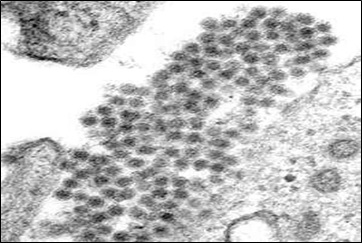Detection of dengue virus in Eastern India
Abstract
Background: Dengue fever is a mosquito-borne tropical disease caused by the dengue virus. Symptoms typically begin three to fourteen days after infection. The virus has four serotypes; infection with one type usually gives lifelong immunity to that type, but only short-term immunity to the others. Subsequent infection with different dengue virus increases the risk of severe complications. A number of tests are available to confirm the diagnosis including detection via Dengue NS1Ag Microlisa and Dengue IgM/IgG Microlisa antibody by ELISA Method.
Methods: There are three methods followed in particular to detect the dengue virus: (A) Dengue NS1 AG Microlisa is designed for in-vitro qualitative detection of Dengue NS1 antigen in human serum or plasma and is used as a screening test for testing of collected blood samples suspected for DENGUE. This method detects all four subtypes; DEN1, DEN2, DEN3 & DEN4 of Dengue Virus. (B) Dengue IgM Microlisa designed for in-vitro qualitative detection of Dengue IgM Antibody in human serum or plasma and is used as a screening test for testing of collected’ blood samples suspected for DENGUE. This method also detects all four subtypes; DEN1, DEN2, DEN3 & DEN4 of Dengue Virus. (C) Dengue IgG Microlisa designed for in vitro qualitative defection on Dengue IgG antibody in human serum / plasma. Duration – 6 months – July, August, September, October, November, December 2019 at KPC Medical College and Hospital, Kolkata West Bengal.
Results: Among 1860 dengue samp1es, 420 sâmp1es were found to be NS1Ag positive 160 samples were found to be IgM positive and 24 samples were found to be IgG positive. Rest Samples negative for all three parameters.
Conclusion: Dengue is a mosquito borne viral infection causing a severe flu like illness and sometimes causing a potentially lethal complication called severe dengue. The incidence of dengue has increased 30 fold over the last 50 years. Up to 50-100 million infections are now estimated to occur annually in over 100 endemic countries, putting almost half of the world’s population at risk. If sever dengue fever can damage the lungs, liver or heart or multiorgan failure. Blood pressure can drop to dangerous levels, causing shock and in some cases death.
Downloads
References
WHO. Dengue Guidelines for Diagnosis, Treatment, Prevention and Control, 2009;(PDF). World Health Organization. Available at https://www.who.int/csr/resources/publications/dengue_9789241547871/en/.
Costa RL, Voloch CM, Schrago CG. Comparative evolutionary epidemiology of dengue virus scrotypes. Infect Genet Evol. 2012;12(2):309-314. doi: https://doi.org/10.1016/j.meegid.2011.12.011.
Dengue virus. Pathogen Information (Path Info). Virginia Bioinformatics Institute, Virginia Tech.
Halstead SB. Pathogenesis of dengue: challenges to molecular biology. Sci. 1988;239(4839):476-481. doi: https://doi.org/10.1126/science.3277268.
Rouvinski A, Guardado-Calvo P, Barba-Spaeth G, Duquerroy S, Vaney MC, Kikuti CM, et al. Recognition determinants of broadly neutralizing human antibodies against dengue viruses. Nature. 2015;520(7545):109-113. doi: https://doi.org/10.1038/nature14130.
East S, World’s first dengue fever vaccine launched in the Philippines. CNN. Available at https://edition.cnn.com/2016/04/06/health/dengue-fever-vaccine-philippines/index.html.
Dengue Fever Vaccine Available in Indonesia. Available at https://www.thejakartapost.com/news/2016/10/25/worlds-first-dengue-vaccine-now-available-in-indonesia.html.
World Health Organization (WHO) Dengue and severe dengue: Fact sheet No: 117. 2013. Available from: http://www.who. Int / mediacentre / factsheets / fs117/en.
Bhatt S, Gething PW, Brady OJ, Messina JP, Farlow AW, Moyes CL, et al. The global distribution and burden of dengue. Nature. 2013;496(7446):504-507. doi: https://doi.org/10.1038/nature12060.
National Vector Borne Diseases Control Programme (NVBDCP), Government of India. Guidelines for clinical management of dengue fever. 2014. Available at http://www.nvbdcp.gov.in/Doc/Dengue-National- Guidelines-2014.pdf.
National Vector Borne Diseases Control Programme (NVBDCP), Directorate- General of Health Services, Government of India. Dengue cases and deaths in the country since. 2010. Available at http://www.nvbdcp.gov.inlden-cd.html.
Nationa1 Vector Borne Diseases Control Programme (NVBDCP), Government of India. Manual on integrated vector management. Available at http://www.nvbdcp.gov.in/Doc/IVM-Manual-Drafl-2015.pdf.
World Health Organization (WHO) Dengue vaccine: WHO Position Paper. 2016. Available at http ://www.who.int/wer/2016/wer9130.pdf?ua=1.
Jain S, Mittal A, Sharma SK, Upadhyay AD, Pandey RM, Sinha S, et al. Predictors of dengue-related mortality and disease severity in a tertiary care center in North India. Open Forum Infect Dis. 2017;5(4):ofxO56. doi: https://doi.org/10.1093/ofid/ofx056.
Ahluwalia G, Sharma SK. Dengue: Current trends and challenges - An Indian perspective. J Assoc Physicians India. 2004;52:561-563.
Bhatt S, Gething PW, Brady OJ, Messina JP, Farlow AW, Moyes CL et.al. The global distribution and burden of dengue. Nature. 2013;496(7446):504-507. doi: https://doi.org/10.1038/nature12060.
Pinheiro FP, Corber SJ. Global situation of dengue and dengue haemorrhagic fever, and its emergence in the Americas. World Health Statistics Quarterly. 1997;50(3-4):1-169.
Gubler DJ, The global emergence/resurgence of arboviral diseases as public health problems. Arch Med Res. 33(4):330-342. doi: https://doi.org/10.1016/s0188-4409(02)00378-8.
Gulati S, Maheshwari A, Atypical manifestations of dengue. Trop Med Int Health. 2007;12(9):1087-1095. doi: https://doi.org/10.1111/j.1365-3156.2007.01891.x.
Kumar R, Tripathi S, Tambe JJ, Arora V, Srivastava A, Nag VL. Dengue encephalopathy in children in Northern India: clinical features and comparison with non-dengue. J Neurol Sci. 2008;269(1-2):41-48. doi: https://doi.org/10.1016/j.jns.2007.12.018.

Copyright (c) 2020 Author (s). Published by Siddharth Health Research and Social Welfare Society

This work is licensed under a Creative Commons Attribution 4.0 International License.


 OAI - Open Archives Initiative
OAI - Open Archives Initiative


